Here in Seattle, we ended July with six consecutive days of 90-plus degree heat—a new record. That is by no means as hot as other parts of the world, but it has been a sobering event here. On the first day of the heat wave, I had gone kayaking. The air was cooler by the water and if I got hot, all I had to do was dip my hands and hat in the water. During the last two days of the heat wave, smoke from wildfires in British Columbia tainted the air a blue haze and the faint smell of wood smoke. Kayaking and all other forms of outdoor exercise weren’t advisable so I was stuck at home. I don’t have air conditioning—most old houses in Seattle don’t—so I got by with fans, an air purifier, and a spray bottle for a cooling mist of water. Even so, the heat and the confinement were stultifying. Thinking there might be some truth in the saying “where the mind goes, the body follows,” I pulled out the color slides of the kayaking trip I took in Greenland 20 years ago. Peering through the loupe at the luminous blue icebergs and the chalk-white glaciers provided the escape I needed.
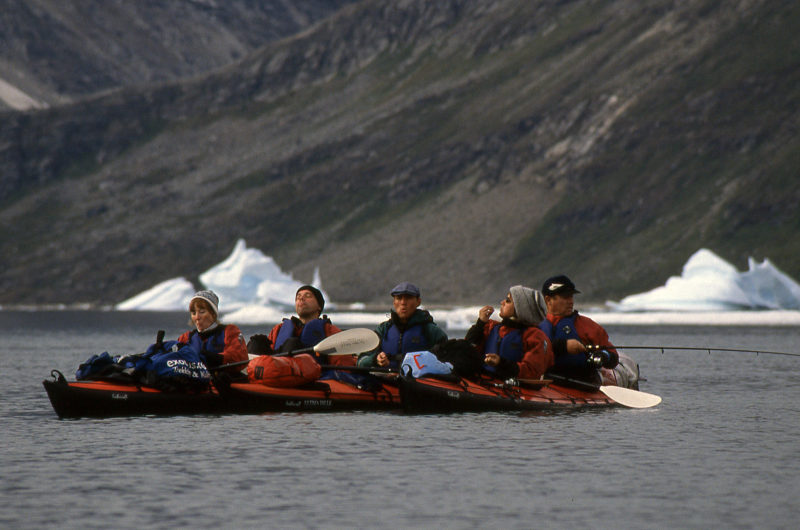 Photographs by the author except as noted
Photographs by the author except as notedThere were nine of us in the group. Here, from left, are Jette and Ole from Denmark, our guide Baldvin from Iceland, and Barbara and Randy from the U.S. They had rafted up for a snack break while paddling north along Sermiligâq Fjord. Randy tried his luck at fishing but never caught anything.
In the summer of 2012, I joined guide Baldvin Kristjansson and seven other paddlers on the southeast coast of Greenland to paddle the 30 miles from the village of Kuummiit to the Knud Rasmussen Glacier. There were icebergs around us from the very start, but they were just bergy bits and growlers—as the smaller floating blocks of ice are called—and few were any larger than the kayaks we paddled. They were interesting as a novelty to me as an outsider, but what captivated me was the color of the water around the kayak. If I looked straight down, the dark reflection of my head obscured the reflections of the clouds and sky, which masked the surface like a film of oil. The water was immaculate, limitless, and a hue of green that I have only seen when I catch a glimpse into the edge of a plate-glass door. It was hard to take my eyes off it.
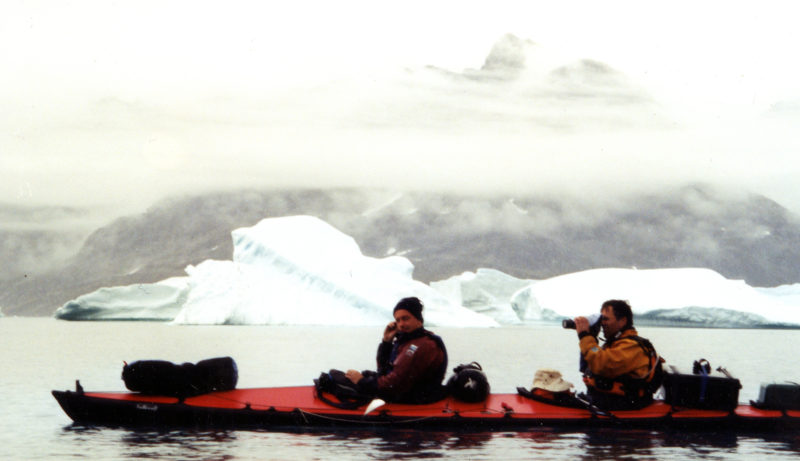 Collection of the author
Collection of the authorErik, from Belgium, and I paddled one of the Feathercraft folding double kayaks. We were both journalists and constantly taking photographs. We would sprint ahead of the group, stop and take pictures as they approached and passed by, and then dart ahead again.
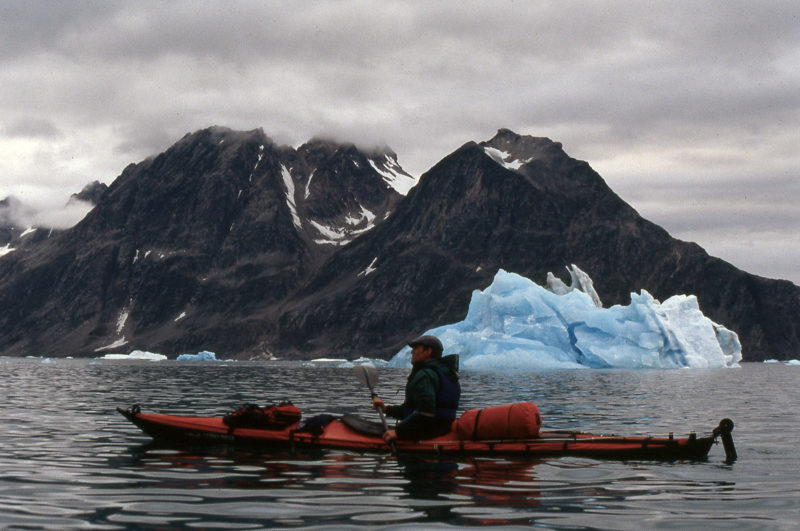
The closer we got to the glacier-fed north end of Sermiligâq, the more icebergs we saw. Many of the peaks flanking the fjord reached heights approaching 4,000′.
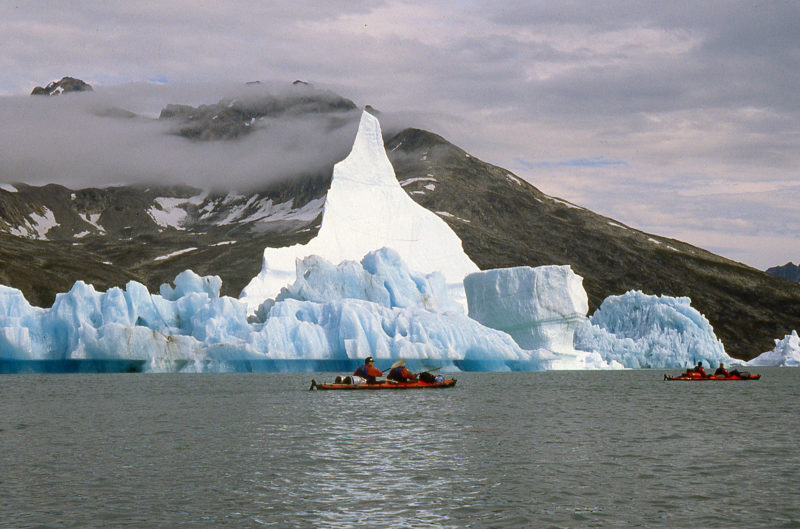
Icebergs that have rolled take on a blue color when the part that has been submerged rises above the water. The blue berg on the left has been undercut, creating an overhang parallel to the water.
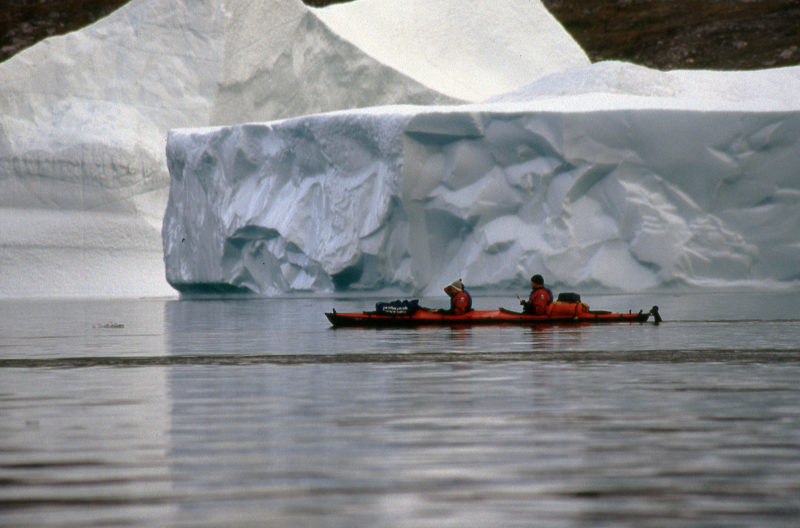
In some places, icebergs as big as city blocks were clustered in groups with avenues between them.
On our second day out, we made camp on a tennis-court-sized patch of flat ground on the north side of Iqateq Fjord. Along the shore there were a few blocks of ice as big as washing machines, and as smooth and translucent as molten glass. In the evening, I hiked up the ridge above the campsite. There were no trees anywhere, just a tangle of tightly woven ground cover that didn’t even grow high enough to snag a boot. From the highest point I reached, I had a good view of the fjord where a half-dozen sugar-white icebergs almost imperceptibly drifted with the ebb tide. Qîanarteq Island hems in the far side of the fjord, and its dull brown flanks mirrored the slope I had climbed. A boat motored in from the east, leaving only a faint gossamer streak of white as its wake. The boat itself was just a speck and the sound of its motor was swallowed up by distance. My realization of the scale of the landscape around me changed in a dizzying instant. The land, the water, and the ice were three or four times larger than they had appeared. The icebergs were not as big as gymnasiums as I had thought; they were as big as stadiums. The fjord was not a few hundred yards across; it spanned nearly a mile.
That experience gave me some insight into inukshuks, the stone cairns that the people of the Arctic have built to mark travel routes, campsites, and other resources. The word is made up of inuk (person), and suk (substitute or stand-in). Some were even made to resemble the human form with legs, outstretched arms, and a head. Not only would they have been an easily recognized mark in a treeless landscape, but they would also stand in for a person and any manmade structure to offer a sense of scale and distance.
By the time I got back to camp, I had broken a sweat. While the others in the group were warming themselves in the kitchen tent with hot tea, I chipped some ice from a waist-high bergy bit on the shore and filled my cup with cold water. The ice fizzed as it melted, releasing air that could well have been trapped in it for thousands of years.
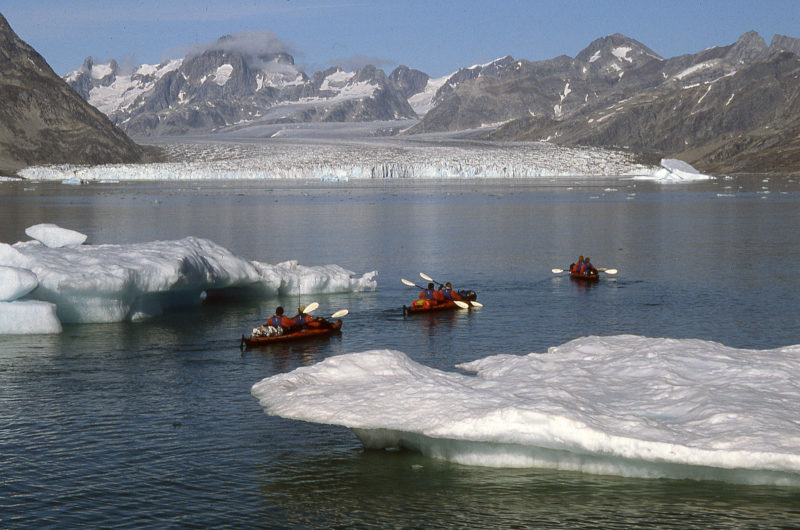
After a lunch break at the north end of Sermiligâq, we headed toward Knud Rasmussen Glacier. Judging the scale of Greenland’s landscape is challenging; I couldn’t fathom that the face of the glacier was 1-1/2 miles wide and 4 miles away.
The day that we paddled the last 10 miles to the glacier, we passed dozens of large icebergs. A few times we heard the rush of falling water as a berg began to roll. The ice that had been above the water was white and the once submerged ice that rose to replace it was light blue, as if Windex or mint mouthwash had been frozen into it. When some bergs rolled, ice turned transparent by being underwater revealed streaks of obsidian black inside. Other bergs that rolled had their history incised in them where ice at the water’s surface had melted quickly, leaving overhangs. Some had a few parallel bands created as they rose, lightened by the meltwater dripping from the top during the day. Others had intersecting grooves, a new one carved after every roll.
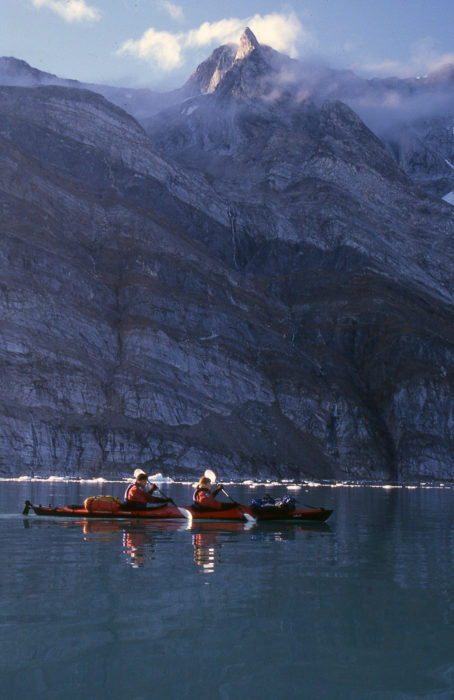
The north side of the inlet leading to the glacier is guarded by an extraordinary face of near-vertical rock. I often asked our guide Baldvin if he knew the names of the geographical features we encountered. I asked him “What is that big cliff called?” He gave me the Greenlandic name and I asked for the English translation. “Big Cliff,” he said. Most of the places we saw had practical and descriptive names like Windy Point or Camping Island.
The air was still on the afternoon that we paddled to the glacier and the quiet undulations in the fjord stretched the reflections of the escarpment into bar-code stripes of white and gray. The 1-1/2-mile width of the glacier made its height hard to judge. Even if there had been an inukshuk next to the south side of the glacier where we were going to camp, it would have been rendered invisible by the 4-mile distance we had to paddle to get there. I don’t know how far we stayed from the face of glacier; it seemed like a few hundred yards, but it might have been closer to a mile. We didn’t see any massive icebergs calve from the glacier, but when smaller bits of ice broke off and fell, they seemed to drop in slow motion.
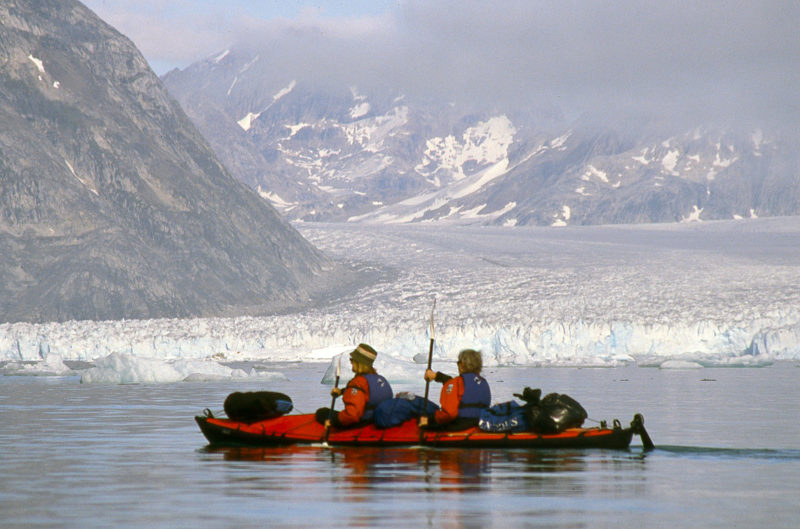
As we got closer to the glacier, we could see the river of ice that was calving the icebergs that drifted out of the inlet, driven by wind and tide.
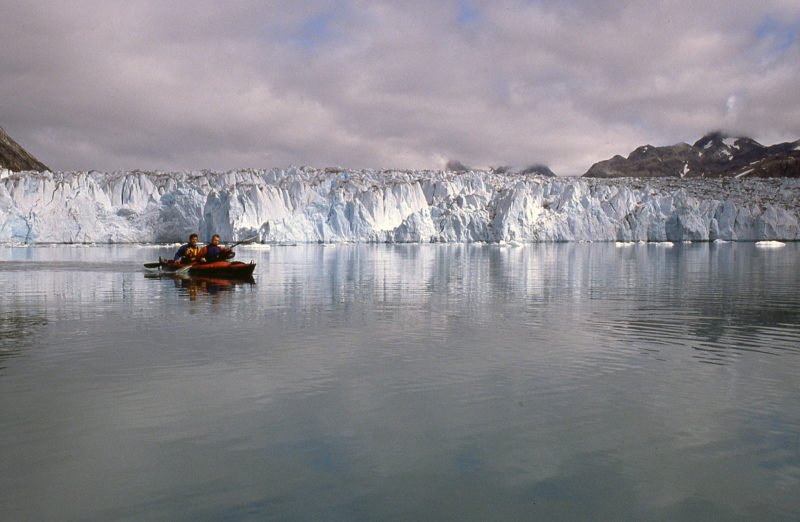
The still water at the glacier face made the wall of ice seem much closer and lower that it was. The cliff of ice was around 180′ high.
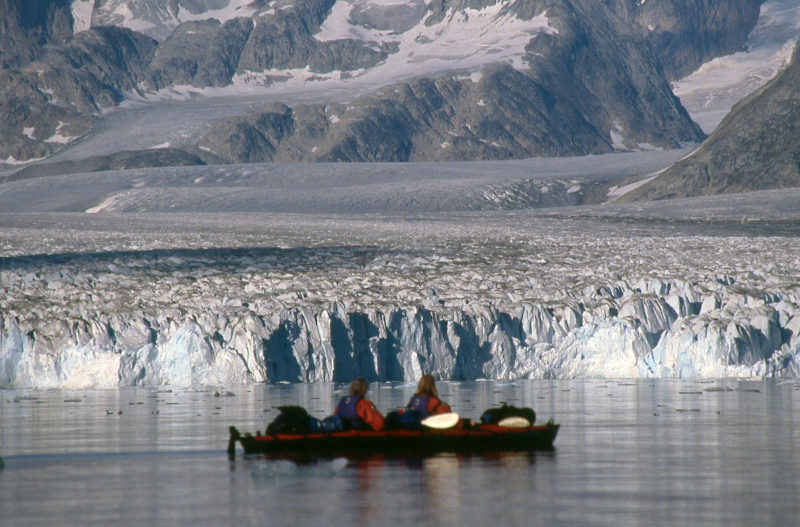
The Knud Rasmussen Glacier is fed by a labyrinth of ice-filled valleys. Some of the ice descends from an elevation of over 3,000′.

We didn’t see any large ice falls while we were paddling along the glacier face at a safe distance, but when the ice cracked it sounded like gunshot.
That night, at a campsite a few hundred yards from the glacier, a pale green aurora borealis lit up the sky and the river of ice cracked and boomed as it spilled itself into the sea.
Looking at my slides and recalling my memories of Greenland’s landscape of ice helped me escape from the stuffy summer heat in Seattle. But it worries me to think it was only a glimpse of a time that has gone by and a landscape that now exists only in my handful of slides.![]()

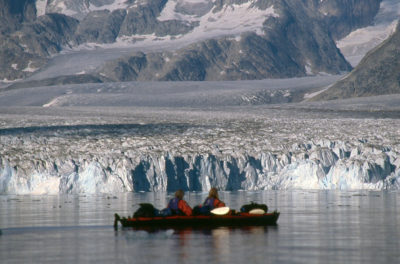

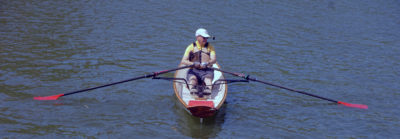

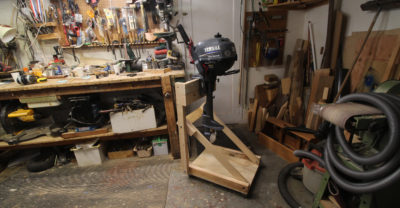

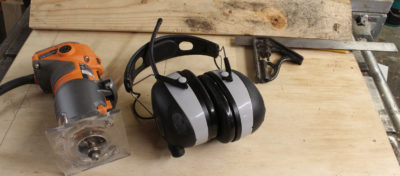

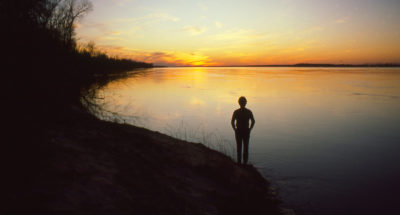
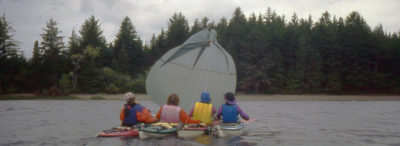
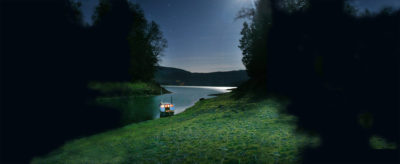
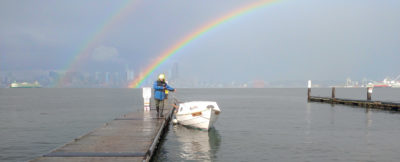
Thank you, Chris, for a wonderful story and amazing images that truly captured the depth perception you were trying to describe (a talent I have yet to master). I especially liked “Big Cliff.”
Chris,
Sometime I would like to hear the short list of things you haven’t done! A beautiful experience beautifully conveyed.
Andy
Stunning photos, Chris. Thank you.
The Feathercrafts you all were paddling are very appropriate boats for kayaking in exotic and far-off places (or should I say were–as the company has given up the ghost. I don’t know whether they still sell spares for existing boats). I have both a single and a double, and have taken several trips with them, mainly to Baja. Today, I am appalled by the idea of hauling the heavy boat bags and camping gear through airports, but somehow we did it.
Of course, now, with the exorbitant fees airlines are charging for cargo, flying with these is really problematic. The last time we returned from Baja, they charged us around $300 or so excess baggage fee just for the return trip. Ouch.
On one trip to Baja (Isla Espiritu Santo near LaPaz), we were assembling the boats on Playa Tecolote on a hot, sunny day. The double (always easier to put together than the single) was pretty straightforward, but the nylon deck on the single had shrunk to the point where the ordeal was eliciting our full repertory of blasphemies. Only later did I realize we could have made the task much easier by dumping buckets of water over the decks to loosen and soften the nylon.
Once together, both boats perform very well on the water, and provide reasonably generous room for packing gear. They handle El Norte, which always brings very lumpy water, with aplomb. On some of those days, even the big (20 ft. or longer) fiberglass pangas stay on the beach.
I have friends with a double Feathercraft who have flown it to Alaska, the Bahamas, Baja, Belize, and Thailand, where they went through the Tsunami of 2004 unscathed.
One advantage of bringing your own boat to such areas is that the rental boats often are not very well maintained and display a history of abuse.
!!!
Thank you for the image journey.
Wonderful pictures, Chris. Thank you for the story.
Regarding airports and luggage, in September 2012 my husband and I took our two Folbot singles (Cooper and Kiawah) to Nova Scotia. The bags weighed in just under 49 pounds and the dimensions qualified as standard checked luggage with no extra fee. We knew that. The staffer at the check-in desk kept reweighing, as she couldn’t believe it was under the 50-pound limit. We had a wonderful time kayaking along the southeastern coast, often in rough conditions with the chop washing over the bow to hit us in the chest. With skirts on, we stayed warm, dry and secure. Beautiful place to paddle.